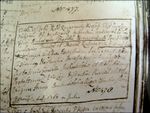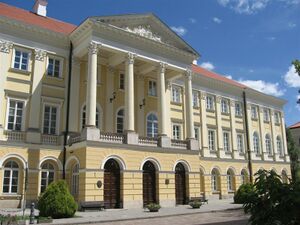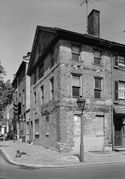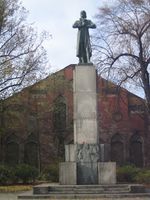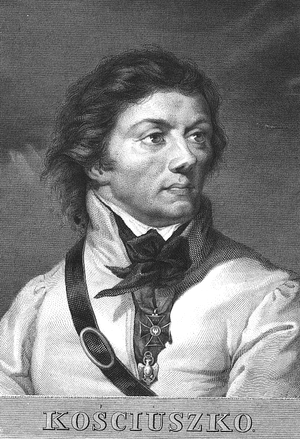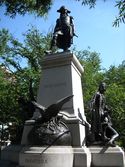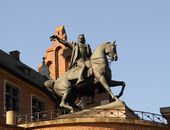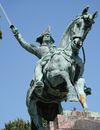تاديوش كوشتشوسكو
تاديوش كوشتشوسكو Tadeusz Kościuszko | |
|---|---|
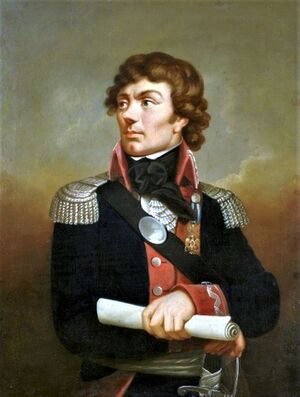 Portrait by Karl Gottlieb Schweikart. Kościuszko is shown wearing the Eagle of the Society of the Cincinnati, awarded to him by General Washington.  Coat of arms: Roch III | |
| اسم الميلاد | Andrzej Tadeusz Bonawentura Kościuszko |
| ولد | 4 فبراير 1746 Mereczowszczyzna، بالقرب من كوسوڤا، دوقية ليتوانيا الكبرى فيما بعد، جزء من الكومنولث الپولندي اللتواني، بلاروس حاليا |
| توفي | 15 أكتوبر 1817 (aged 71) سولوثورن، سويسرا |
| الولاء |
|
| الخدمة/ | |
| سنين الخدمة | 1765–1794 |
| الرتبة |
|
| الوحدة |
|
| المعارك/الحروب | |
| الأوسمة | |
| التوقيع | |
أندرِيْ تاديوش بوناڤنتورا كاوتشسكو (بالبيلاروسية: Andréj Tadévuš Banavientúra Kasciúška, إنگليزية: Andrew Thaddeus Bonaventure Kosciuszko;[note 1]؛ عاش 4 فبراير، 1746 - 15 أكتوبر، 1817)، هو Polish military engineer, statesman, and military leader who became a national hero in Belarus, France, Lithuania, Poland and the United States.[3][4][5][6][7] He fought in the Polish–Lithuanian Commonwealth's struggles against Russia and Prussia, and on the US side in the American Revolutionary War. As Supreme Commander of the Polish National Armed Forces, he led the 1794 Kościuszko Uprising.
Kościuszko was born in February 1746, in a manor house on the Mereczowszczyzna estate in Brest Litovsk Voivodeship, then Grand Duchy of Lithuania, a part of the Polish–Lithuanian Commonwealth (now Ivatsevichy District of Belarus).[8] At age 20, he graduated from the Corps of Cadets in Warsaw, Poland. After the start of the civil war in 1768, Kościuszko moved to France in 1769 to study. He returned to the Commonwealth in 1774, two years after the First Partition, and was a tutor in Józef Sylwester Sosnowski's household. In 1776, Kościuszko moved to North America, where he took part in the American Revolutionary War as a colonel in the Continental Army. An accomplished military architect, he designed and oversaw the construction of state-of-the-art fortifications, including those at West Point, New York. In 1783, in recognition of his services, the Continental Congress promoted him to brigadier general.
Upon returning to Poland in 1784, Kościuszko was commissioned as a major general in the Polish–Lithuanian Commonwealth Army in 1789. After the Polish–Russian War of 1792 resulted in the Commonwealth's Second Partition, he commanded an uprising against the Russian Empire in March 1794 until he was captured at the Battle of Maciejowice in October 1794. The defeat of the Kościuszko Uprising that November led to Poland's Third Partition in 1795, which ended the Commonwealth. In 1796, following the death of Tsaritsa Catherine II, Kościuszko was pardoned by her successor, Tsar Paul I, and he emigrated to the United States. A close friend of Thomas Jefferson, with whom he shared ideals of human rights, Kościuszko wrote a will in 1798, dedicating his U.S. assets to the education and freedom of the U.S. slaves. Kościuszko eventually returned to Europe and lived in Switzerland until his death in 1817. The execution of his testament later proved difficult, and the funds were never used for the purpose Kościuszko intended.
. . . . . . . . . . . . . . . . . . . . . . . . . . . . . . . . . . . . . . . . . . . . . . . . . . . . . . . . . . . . . . . . . . . . . . . . . . . . . . . . . . . . . . . . . . . . . . . . . . . . . . . . . . . . . . . . . . . . . . . . . . . . . . . . . . . . . . . . . . . . . . . . . . . . . . . . . . . . . . . . . . . . . . . .
النشأة
Kościuszko was born in February 1746 in a manor house on the Mereczowszczyzna estate near Kosów in Nowogródek Voivodeship, Grand Duchy of Lithuania, a part of the Polish–Lithuanian Commonwealth.[9][10] His exact birthdate is unknown; commonly cited are 4 February[9] and 12 February.[note 2] Kościuszko was the youngest son of a member of the Szlachta (untitled Polish nobility), Ludwik Tadeusz Kościuszko, an officer in the Polish–Lithuanian Commonwealth Army, and his wife Tekla Ratomska.[13] The family held the Polish Roch III coat of arms.[14] At the time of Tadeusz Kościuszko's birth, the family possessed modest landholdings in the Grand Duchy worked by 31 peasant families.[15][16]
Tadeusz was baptized in the Catholic church, thereby receiving the names Andrzej, Tadeusz, and Bonawentura.[17][18][19][20] His paternal family was ethnically Lithuanian–Ruthenian[15] and traced their ancestry to Konstanty Fiodorowicz Kostiuszko, a courtier of Polish King and Grand Duke of Lithuania Sigismund I the Old.[21] Kościuszko's maternal family, the Ratomskis, were also Ruthenian.[22]
Modern Belarusian writers interpret his Ruthenian or Lithuanian heritage as Belarusian.[23] He once described himself as a Litvin,[22] a term that denoted inhabitants of the Grand Duchy of Lithuania, within the Polish–Lithuanian Commonwealth. Modern Belarusian Litvinist writers interpret Litvin as designating a Belarusian, before the word "Belarusian" had come into use.[24] His family had become Polonized as early as the 16th century.[25] Like most Polish–Lithuanian nobility of the time, the Kościuszkos spoke Polish and identified with Polish culture.[26]
In 1755, Kościuszko began attending school in Lubieszów but never finished due to his family's financial straits after his father's death in 1758. Poland's King Stanisław August Poniatowski established a Corps of Cadets (Korpus Kadetów) in 1765, at what is now Warsaw University, to educate military officers and government officials. Kościuszko enrolled in the Corps on 18 December 1765, likely thanks to the Czartoryski family's patronage. The school emphasized military subjects and the liberal arts,[27] and after graduating on 20 December 1766, Kościuszko was promoted to chorąży (a military rank roughly equivalent to modern lieutenant). He stayed on as a student instructor and, by 1768, had attained the rank of captain.[13]
درسدن وباريس


الثورة الأمريكية
On learning of the American Revolution, Kościuszko, a man of revolutionary aspirations, sympathetic to the American cause and an advocate of human rights, sailed for America in June 1776 along with other foreign officers, likely with the help of a French supporter of the American revolutionaries, Pierre Beaumarchais.[13][28] On 30 August 1776, Kościuszko submitted an application to the Second Continental Congress. He was assigned to the Continental Army the next day.[13]
Northern region
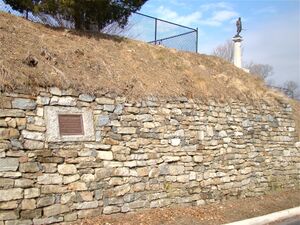
Kościuszko's first task was building fortifications at Fort Billingsport in Paulsboro, New Jersey, to protect the banks of the Delaware River and prevent a possible British advance up the river to Philadelphia.[29] He initially served as a volunteer in the employ of Benjamin Franklin, but on 18 October 1776, Congress commissioned him a colonel of engineers in the Continental Army.[30]
In spring 1777, Kościuszko was attached to the Northern Army under Major General Horatio Gates, arriving at the Canada–US border in May 1777. Subsequently posted to Fort Ticonderoga, he reviewed the defences of what had been one of the most formidable fortresses in North America.[13][31] His surveys prompted him to strongly recommend the construction of a battery on Sugar Loaf, a high point overlooking the fort.[31] His prudent recommendation, in which his fellow engineers concurred, was turned down by the garrison commander, Brigadier General Arthur St. Clair.[13][31]
This proved a tactical blunder: when a British army under General John Burgoyne arrived in July 1777, Burgoyne did exactly what Kościuszko had warned of, and had his engineers place artillery on the hill.[31] With the British in complete control of the high ground, the Americans realized their situation was hopeless and abandoned the fortress with hardly a shot fired in the siege of Ticonderoga.[31] The British advance force nipped hard on the heels of the outnumbered and exhausted Continentals as they fled south. Major General Philip Schuyler, desperate to put distance between his men and their pursuers, ordered Kościuszko to delay the enemy.[32] Kościuszko designed an engineer's solution: his men felled trees, dammed streams, and destroyed bridges and causeways.[32] Encumbered by their huge supply train, the British began to bog down, giving the Americans the time needed to safely withdraw across the Hudson River.[32]
Gates tapped Kościuszko to survey the country between the opposing armies, choose the most defensible position, and fortify it. Finding just such a spot near Saratoga, overlooking the Hudson at Bemis Heights, Kościuszko laid out a robust array of defences, nearly impregnable. His judgment and meticulous attention to detail frustrated the British attacks during the Battle of Saratoga,[13] and Gates accepted the surrender of Burgoyne's force there on 16 October 1777.[33] The dwindling British army had been dealt a sound defeat, turning the tide to American advantage.[34] Kościuszko's work at Saratoga received great praise from Gates, who later told his friend Dr. Benjamin Rush: "The great tacticians of the campaign were hills and forests, which a young Polish engineer was skillful enough to select for my encampment."[13]
At some point in 1777, Kościuszko composed a polonaise and scored it for the harpsichord. Named for him, and with lyrics by Rajnold Suchodolski, it later became popular with Polish patriots during the November 1830 Uprising.[35] Around that time, Kościuszko was assigned an African American orderly, Agrippa Hull, whom he treated as an equal and a friend.[36]
In March 1778 Kościuszko arrived at West Point, New York, and spent more than two years[37] strengthening the fortifications and improving the stronghold's defences.[38][39] It was these defences that the American General Benedict Arnold subsequently attempted to surrender to the British when he defected.[40] Soon after Kościuszko finished fortifying West Point, in August 1780, General George Washington granted Kościuszko's request to transfer to combat duty with the Southern Army. Kościuszko's West Point fortifications were widely praised as innovative for the time.[41][42]
Southern region
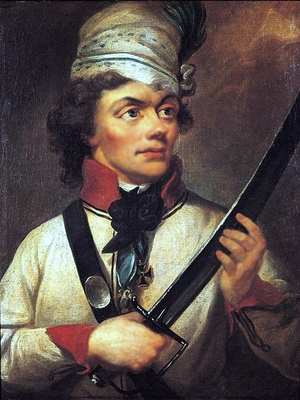
After travelling south through rural Virginia in October 1780, Kościuszko proceeded to North Carolina to report to his former commander General Gates.[38] Following Gates's disastrous defeat at Camden on 16 August 1780, the Continental Congress selected Washington's choice, Major General Nathanael Greene, to replace Gates as commander of the Southern Department.[43] When Greene formally assumed command on 3 December 1780, he retained Kościuszko as his chief engineer. By then, he had been praised by both Gates and Greene.[38]
During this campaign, Kościuszko was placed in command of building bateaux, siting the location for camps, scouting river crossings, fortifying positions, and developing intelligence contacts. Many of his contributions were instrumental in preventing the destruction of the Southern Army. This was especially so during the "Race to the Dan", when British General Charles Cornwallis chased Greene across 200 miles (320 km) of rough backcountry in January and February 1781. Thanks largely to a combination of Greene's tactics, Kościuszko's bateaux, and accurate scouting of the rivers ahead of the main body, the Continentals safely crossed each river, including the Yadkin and the Dan.[38] Cornwallis, having no boats, and finding no way to cross the swollen Dan, abandoned the chase and withdrew into North Carolina. The Continentals regrouped south of Halifax, Virginia, where Kościuszko had earlier, at Greene's request, established a fortified depot.[44]
During the Race to the Dan, Kościuszko had helped select the site where Greene eventually returned to fight Cornwallis at Guilford Courthouse. Though tactically defeated, the Americans all but destroyed Cornwallis' army as an effective fighting force and gained a permanent strategic advantage in the South.[45] Thus, when Greene began his reconquest of South Carolina in the spring of 1781, he summoned Kościuszko to rejoin the main body of the Southern Army. The combined forces of the Continentals and Southern militia gradually forced the British from the backcountry into the coastal ports during the latter half of 1781 and, on 25 April, Kościuszko participated in the Second Battle of Camden.[46] At Ninety-Six, Kościuszko besieged the Star Fort from 22 May to 18 June. During the unsuccessful siege, he suffered his only wound in seven years of service, bayonetted in the buttocks during an assault by the fort's defenders on the approach trench that he was constructing.[47]
Kościuszko subsequently helped fortify the American bases in North Carolina,[48] before taking part in several smaller operations in the final year of hostilities, harassing British foraging parties near Charleston, South Carolina. After the death of his friend Colonel John Laurens, Kościuszko became engaged in these operations, taking over Laurens's intelligence network in the area. He commanded two cavalry squadrons and an infantry unit, and his last known battlefield command of the war occurred at James Island, South Carolina, on 14 November 1782. In what has been described as the Continental Army's final armed action of the war,[49] he was nearly killed as his small force was routed.[50] A month later, he was among the Continental troops that reoccupied Charleston following the city's British evacuation. Kościuszko spent the rest of the war there, conducting a fireworks display on 23 April 1783, to celebrate the signing of the Treaty of Paris earlier that month.[51]
العودة للوطن

Having not been paid in his seven years of service, in late May 1783, Kościuszko decided to collect the salary owed to him.[52] That year, he was asked by Congress to supervise the fireworks during the 4 July celebrations at Princeton, New Jersey.[53] On 13 October 1783, Congress promoted him to brigadier general, but he still had not received his back pay. Many other officers and soldiers were in the same situation.[54] While waiting for his pay, unable to finance a voyage back to Europe, Kościuszko, like several others, lived on money borrowed from the Polish–Jewish banker Haym Solomon. Eventually, he received a certificate for 12,280 dollars, at 6%, to be paid on 1 January 1784 (equivalent to ~$323,000, paid as installments ~$19,400 a month in 2022), and the right to 500 acres (202.34 ha; 0.78 sq mi) of land, but only if he chose to settle in the United States.[55] For the winter of 1783–84, his former commanding officer, General Greene, invited Kościuszko to stay at his mansion.[56] He was inducted into the Society of the Cincinnati[38][57] and into the American Philosophical Society in 1785.[58] During the Revolution Kościuszko carried an old Spanish sword at his side, which was inscribed with the words, Do not draw me without reason; do not sheathe me without honour.[59]
. . . . . . . . . . . . . . . . . . . . . . . . . . . . . . . . . . . . . . . . . . . . . . . . . . . . . . . . . . . . . . . . . . . . . . . . . . . . . . . . . . . . . . . . . . . . . . . . . . . . . . . . . . . . . . . . . . . . . . . . . . . . . . . . . . . . . . . . . . . . . . . . . . . . . . . . . . . . . . . . . . . . . . . .
الكومنولث الپولندي-اللتواني
On 15 July 1784, Kościuszko set off for Poland, where he arrived on 26 August. Due to a conflict between his patrons, the Czartoryski family, and King Stanisław August Poniatowski, Kościuszko once again failed to get a commission in the Commonwealth Army. He settled in Siechnowicze.[38] His brother Józef had lost most of the family's lands through bad investments, but with the help of his sister Anna, Kościuszko secured part of the lands for himself.[60] He decided to limit his male peasants' corvée (obligatory service to the lord of the manor) to two days a week and completely exempted the female peasants. His estate soon stopped being profitable, and he began going into debt.[38] The situation was not helped by the failure of the money promised by the American government—interest on late payment for his seven years' military service—to materialize.[61] Kościuszko struck up friendships with liberal activists; Hugo Kołłątaj offered him a position as lecturer at Kraków's Jagiellonian University, which Kościuszko declined.[62]
Finally, the Great Sejm of 1788–92 introduced some reforms, including a planned build-up of the army to defend the Commonwealth's borders. Kościuszko saw a chance to return to military service and spent some time in Warsaw, among those who engaged in the political debates outside the Great Sejm. He wrote a proposal to create a militia force, on the American model.[38][63] As political pressure grew to build up the army, and Kościuszko's political allies gained influence with the King, Kościuszko again applied for a commission, and on 12 October 1789, received a royal commission as a major general, but to Kosciuszko's dismay[64] in the Army of the Kingdom of Poland.[38] He began receiving the high salary of 12,000 zlotys a year, ending his financial difficulties. On 1 February 1790, he reported for duty in Włocławek, and wrote in a letter after a few days, calling the local inhabitants "lazy" and "careless", in contrast to "good and economical Lithuanians". In the same letter, Kosciuszko begged general Franciszek Ksawery Niesiołowski for a transfer to the Army of the Grand Duchy of Lithuania, but his wishes were not granted.[64] Around summer, he commanded some infantry and cavalry units in the region between the Bug and Vistula Rivers. In August 1790 he was posted to Volhynia, stationed near Starokostiantyniv and Międzyborze.[38] Prince Józef Poniatowski, who happened to be the King's nephew, recognized Kościuszko's superior experience and made him his second-in-command, leaving him in command when he was absent.[65]
Meanwhile, Kościuszko became more closely involved with the political reformers, befriending Hugo Kołłątaj, Julian Ursyn Niemcewicz and others.[66] Kościuszko argued that the peasants and Jews should receive full citizenship status, as this would motivate them to help defend Poland in the event of war.[67] The political reformers centered in the Patriotic Party scored a significant victory with adopting the Constitution of 3 May 1791. Kościuszko saw the Constitution as a step in the right direction but was disappointed that it retained the monarchy and did little to improve the situation of the most underprivileged, the peasants and the Jews.[68] The Commonwealth's neighbors saw the Constitution's reforms as a threat to their influence over Polish internal affairs. A year after the Constitution's adoption, on 14 May 1792, reactionary magnates formed the Targowica Confederation, which asked Russia's Tsaritsa Catherine II for help in overthrowing the Constitution. Four days later, on 18 May 1792, a 100,000-man Russian army crossed the Polish border, headed for Warsaw, beginning the Polish–Russian War of 1792.[69]
الدفاع عن الدستور
انتفاضة كوشتشوسكو
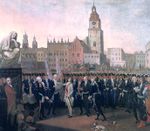
 مقالة مفصلة: انتفاضة كوشتشوسكو
مقالة مفصلة: انتفاضة كوشتشوسكو
الموسيقى
In 1777, Kościuszko composed a polonaise and scored it for the harpsichord. It was named after him, and became popular among Polish patriots at the time of the November Uprising in 1830-31, with lyrics written by Rajnold Suchodolski.[70]
حياته لاحقاً
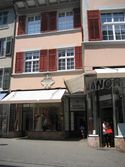
In 1796 Tsar Paul I of Russia pardoned Kościuszko and set him free. In exchange for his oath of loyalty, Paul I also freed some 20,000 Polish political prisoners held in Russian prisons and forcibly settled in Siberia. The Tsar granted Kościuszko 12,000 roubles, which the Polish leader attempted in 1798 to return; the Tsar refused to accept it back as "money from a traitor".

تخليد ذكراه
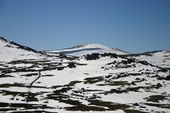
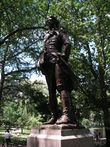
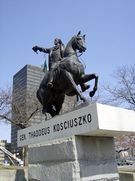

As a national hero in Poland, Lithuania, Belarus, and the United States, Kościuszko has given his name to many places around the world and numerous monuments. The Polish explorer Count Paweł Edmund Strzelecki named the highest mountain in Australia, Mount Kosciuszko, after him. The mountain is the central feature of Kosciuszko National Park.
. . . . . . . . . . . . . . . . . . . . . . . . . . . . . . . . . . . . . . . . . . . . . . . . . . . . . . . . . . . . . . . . . . . . . . . . . . . . . . . . . . . . . . . . . . . . . . . . . . . . . . . . . . . . . . . . . . . . . . . . . . . . . . . . . . . . . . . . . . . . . . . . . . . . . . . . . . . . . . . . . . . . . . . .
آراء عن كوشتشوسكو
- ناپليون بوناپرت called Kosciuszko: “the hero of the North.”[72]
- توماس جيفرسون وصفه بأنه: "as pure a son of liberty as I have ever known."
- French historian Jules Michelet called him “the last knight.”
- Jewish Cavalry Leader Berek Joselewicz called Kosciuszko “a messenger from God Almighty.”
- Lord Byron: “That sound that crashes in the tyrant’s ear – Kosciuszko!”
- Catherine the Great called him “a beast.”
- Mikael Dziewanowski claims he was a "pioneer of emancipation and a spokesman for racial democracy and justice in eighteenth-century America."[73]
انظر أيضاً
- Kazimierz Pułaski (Anglicized as "Casimir Pulaski"), another Polish commander in the American Revolutionary War
- مؤسسة كوشتشوسكو
- قائمة البولنديين
الهامش
- ^ Bumblauskas, 1994, p. 4.
- ^ President Komorowski Honors Kosciuszko at West Point at YouTube, 3′33″.
- ^ A museum dedicated to the Polish military hero Tadeusz Kościuszko. "Kościuszko Museum - The Kościuszko Museum has existed in Solothurn (Switzerland) at Gurzelngasse 12 since 1936. The Polish national hero Tadeusz Kościuszko lived and died in this house". www.solothurn-city.ch (in الإنجليزية). Retrieved 6 June 2022.
Life of the Polish military hero Tadeusz Kościuszko – who spent the last few years of his life in Solothurn from 1814 to 1817 – through documents, images and objects. The house where he died was converted into the Kościuszko Museum and represents both his close relationship with Solothurn and a piece of world history.
- ^ Dolan, Sean (1997). The Polish Americans (in الإنجليزية). Chelsea House. ISBN 978-0-7910-3364-7.
- ^ Greene, Meg (2002). Thaddeus Kos ́ciuszko: Polish General and Patriot (in الإنجليزية). Infobase Publishing. ISBN 978-1-4381-2513-8.
- ^ "2015 Programs and Events | Minsk, Belarus - Embassy of the United States". 17 November 2015. Archived from the original on 2015-11-17.
- ^ Memorial Exhibition Thaddeus Kosciuszko, Revered Polish and American Hero, His Patriotism, Vision, and Zeal Revealed in a Collection of Autograph Letters by Him: As Well in a Collection of Autograph Letters about Him by Prominent Leaders of the American Revolution and Other, Also Oil Painting, Medals, Engravings, Books, Broadsides and Other Relics Being the Collection Formed by Dr.&Mrs. Alexander Kahanowicz : Exhibition from Sunday, May Fifteenth to June Eleventh, The Anderson Galleries [...], New York (in الإنجليزية). Anderson Galleries - The Metropolitan Museum of Art. 1927.
- ^ Уладзімер Арлоў «Імёны Свабоды» (Uladzimer Arloǔ “The Names of Freedom”)(in Belarusian) pp 26-27
- ^ أ ب Herbst, 1969 p. 430.
- ^ Institute of World Politics, 2009, article.
- ^ Szyndler, 1994, p. 103.
- ^ Storozynski, 2009, p. 13.
- ^ أ ب ت ث ج ح خ د Herbst, 1969 p. 431.
- ^ Szyndler, 1991, p. 476.
- ^ أ ب Cizauskas 1986, pp. 1–10.
- ^ Storozynski, 2011, p. 2.
- ^ Szyndler, 1991, p. 27.
- ^ Krol, 2005, Public address.
- ^ Gardner, 1920 p. 317.
- ^ Kajencki, 1998, p. 54.
- ^ Korzon, 1894, p. 135.
- ^ أ ب Новости [Novosti], 2009, p. 317.
- ^ Sanko & Saverchenko, 1999, p. 82.
- ^ Под ред, 2006, pp. 206–08.
- ^ 100 Great Aristocrats, Essay.
- ^ Storozynski, 2011, p. 27.
- ^ Storozynski, 2011, p. 28.
- ^ خطأ استشهاد: وسم
<ref>غير صحيح؛ لا نص تم توفيره للمراجع المسماةStorozynski pp. 17–18. - ^ Colimore, news article.
- ^ Storozynski, 2011, pp. 41–42.
- ^ أ ب ت ث ج Storozynski, 2011, pp. 47–52.
- ^ أ ب ت Storozynski, 2011, pp. 53–54.
- ^ Afflerbach, 2012, pp. 177–79.
- ^ Storozynski, 2011, p. 65.
- ^ Anderton, 2002, Vol. 5, No. 2.
- ^ Storozynski, 2011, pp. 111–12.
- ^ U.S.Government Printing Office, 1922.
- ^ أ ب ت ث ج ح خ د ذ ر Herbst, 1969, p. 43.
- ^ Storozynski, 2011, p. 85.
- ^ Storozynski, 2011, pp. 128–30.
- ^ Storozynski, 2011, pp. 131–32.
- ^ Palmer, 1976, pp. 171–74.
- ^ Storozynski, 2011, pp. 141–42.
- ^ Storozynski, 2011, pp. 144–46.
- ^ Storozynski, 2011, p. 147.
- ^ Storozynski, 2011, p. 148.
- ^ Storozynski, 2011, pp. 149–53.
- ^ Storozynski, 2011, p. 154.
- ^ Kajencki, 1998, p. 174.
- ^ Storozynski, 2011, pp. 158–60.
- ^ Storozynski, 2011, pp. 161–62.
- ^ Storozynski, 2011, p. 163.
- ^ Storozynski, 2011, p. 164.
- ^ Storozynski, 2009, p. 114.
- ^ Storozynski, 2011, pp. 166–67.
- ^ Storozynski, 2011, p. 168.
- ^ Gardner, 1920 p. 31
- ^ "APS Member History". search.amphilsoc.org. Retrieved 14 December 2020.
- ^ Lengel, 2017, p. 105
- ^ Storozynski, 2011, p. 177.
- ^ Storozynski, 2011, p. 178.
- ^ Storozynski, 2011, p. 181.
- ^ Storozynski, 2011, p. 187.
- ^ أ ب Niezwykle też rozdrażnienie odbiło się w liście, pisanym do generała Niesiołowskiego z Włocławka d. 7 lutego 1790 r.: ,,Zaklinam na wszystko, co jest w życiu najmilszego, to jest żoneczkę i dziatki . . . abyś chciał JWPan Dobrodziej wyrwać mnie z miejsca tak nieprzyjemnego, kosztownego i nic jeszcze nic mającego. Bóg widzi: słowa nie mam do kogo przemówić - i dobrze, bo z wołami nigdy nie gadałem. Co za Gaskony ! Ale dam pokój opisywać krajowych; powiem tylko, że kraj piękny i tenby być powinien dla poczciwych i gospodarnych Litwinów przeznaczonym, a nie dla nich, gnuśnych i niedbałych. Chciejcie mnie powrócić do Litwy; chyba się wyrzekacie mnie i niezdolnym widzicie do służenia wam? Któż jestem? Azali nie Litwin, śpółrodak wasz, od was wybrany? Komuż mam wdzięczność okazywać (za rekomendacyę sejmiku brzeskiego?), jeżeli nie wam? Kogo mam bronić, jeżeli nie was i siebie samego? Jeżeli to was nie zmiękczy do wniesienia o mnie na Sejmie, abym powrócił: to ja, sam chyba, Bóg widzi , co złego sobie zrobię ! no złość mnie bierze: z Litwy abym w Koronie służyl, gdy wy nie macie trzech generałów. Kiedy was nizać na sznurku będzie przemoc, wtenczas chyba ockniecie się i o siebie dbać będziecie" from Siemieński's "Listy Kościuszki", no. 62, p. 162 and p. 206 of the book "Kościuszko. Biografia z dokumentów wysnuta" by Tadeusz Korzon.
- ^ Storozynski, 2011, p. 203.
- ^ Storozynski, 2011, p. 194.
- ^ Storozynski, 2011, p. 195.
- ^ Storozynski, 2011, pp. 213–14.
- ^ Storozynski, 2011, pp. 218–23.
- ^ Margaret Anderton, "The Spirit of the Polonaise," Polish Music Journal Vol. 5, No. 2, Winter 2002.
- ^ Zacharias, Pat, The Monuments of Detroit, September 5, 1999. Detroit News
- ^ Alex Storozynski (2009). The Peasant Prince: Thaddeus Kosciuszko and the Age of Revolution. Macmillan. p. 114. ISBN 9780312388027.
- ^ Mikael Dziewanowski's "Tadeuz Kościuszko, Kazimierz Puaski, and the American War of Independence," in Jaraslaw Pelenki, ed., The American and European Revolutions, 1776-1848: Sociopolitical and Ideological Aspects; Proceedings of the Second Bicentennial Conference of Polish and American Historians, September 29 — October 1, 1976 (Iowa City: University of Iowa Press, 1980).
المصادر
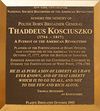
- Pula, James S. (1998). Thaddeus Kosciuszko: The Purest Son of Liberty. Hippocrene Books. ISBN 0781805767.
{{cite book}}: Cite has empty unknown parameter:|coauthors=(help) - Niestsiarchuk, Leanid (2006). Андрэй Тадэвуш Банавентура Касцюшка: Вяртаннегероя нарадзіму (Andrzej Tadeusz Bonawentura Kosciuszko: Return of the Hero to his Motherland) (in Belarusian). ISBN 9856665930.
{{cite book}}: Cite has empty unknown parameter:|coauthors=(help)CS1 maint: unrecognized language (link) - Nash, Gary B. (2008). Friends of Liberty: Thomas Jefferson, Thaddeus Kosciuszko, and Agrippa Hull. Basic Books. ISBN 9780465048144.
{{cite book}}: Unknown parameter|coauthors=ignored (|author=suggested) (help) - Storozynski, Alex (2009). The Peasant Prince: Thaddeus Kosciuszko and The Age of Revolution, Thomas Dunne Books, ISBN 978-0-312-38802-7, ISBN 0-312-38802-0
- Manfred Kridl, ed., For Your Freedom and Ours.
وصلات خارجية
- The Peasant Prince (Unknown story of Kosciuszko’s life, liberty and pursuit of tolerance during the age of revolution)Storozynski, Alex (2009). The Peasant Prince: Thaddeus Kosciuszko and The Age of Revolution, Thomas Dunne Books, ISBN 978-0-312-38802-7, ISBN 0-312-38802-0
- Thaddeus Kosciuszko as an Artist (book about the Polish-American hero.)
- Kosciuszko by Monica Mary Gardner
- The Kosciuszko Foundation. (Polish-American cultural foundation named for General Tadeusz Kosciuszko.)
- Mt. Kosciuszko Inc. Webpage of Australia's Mt. Kosciuszko Association (named for Australia's highest mountain peak).
- About.com feature on Tadeusz Kosciuszko.
- Polish Embassy in the United States: a tribute page.
- US Kosciuszko National Monument web site.
- Kosciuszko Polish-American Historical Society, Inc., of the Valley Ansonia - Derby - Shelton - Seymour, Connecticut.
- Kosciuszko monuments gallery.
- Tadeusz Kościuszko at Find-a-grave.
- Unknown Kościuszko manuscript (Nieznany rękopis Tadeusza Kościuszki).
- Photographs of Mereszowszczyzna manor in Belarus.
- A humorous biographical comic about Kościuszko.
- Will of Thaddeus Kosciuszko.
- Henri La Fayette Villaume Ducoudray Holstein (1833). Le Glaneur Francais, Number One. pp. 251–252.
خطأ استشهاد: وسوم <ref> موجودة لمجموعة اسمها "note"، ولكن لم يتم العثور على وسم <references group="note"/>
- Short description is different from Wikidata
- Articles with hatnote templates targeting a nonexistent page
- Missing redirects
- Articles containing بلاروسية-language text
- Articles containing إنگليزية-language text
- Pages using Lang-xx templates
- CS1 errors: unsupported parameter
- Persondata templates without short description parameter
- مواليد 1746
- وفيات 1817
- People from Ivatsevichy Raion
- Members of the Society of the Cincinnati
- نبلاء بولنديون
- جنرالات بولنديون
- جنرالات بولنديون في جيوش أخرى
- سياسيون بولنديون
- حائزو مرتبة النسر الأبيض (پولندا)
- حائزو ڤيرتوتي ميليتاري
- جنرالات الجيش الثاري
- بولنديون من الثورة الأمريكية
- مهاجرون بولنديون إلى الولايات المتحدة
- مواطنون مجنسون في الولايات المتحدة
- أمريكان من أصل بولندي
- Kościuszko insurgents
- أشخاص من الحرب البولندية الروسية 1792
- مهندسون بولنديون
- Burials at the Chapel of the Royal Castle, Warsaw
- Generals of the Polish–Lithuanian Commonwealth
- سياسيون ليتوانيون
- Burials at Archcathedral Basilica of Sts. Stanisław and Vaclav, Kraków

